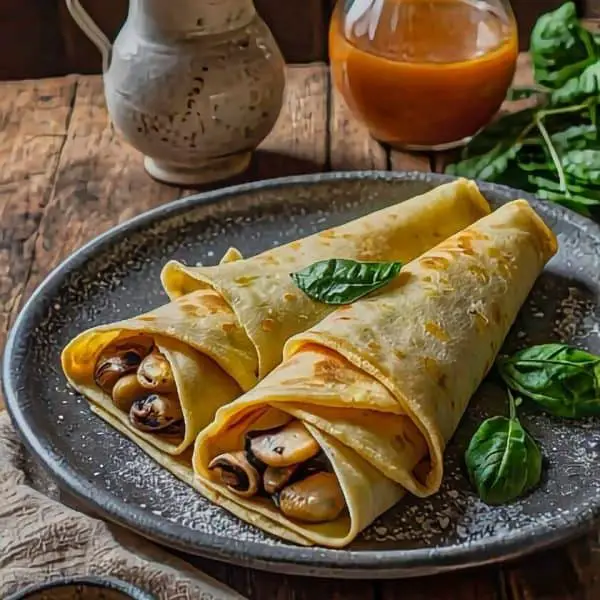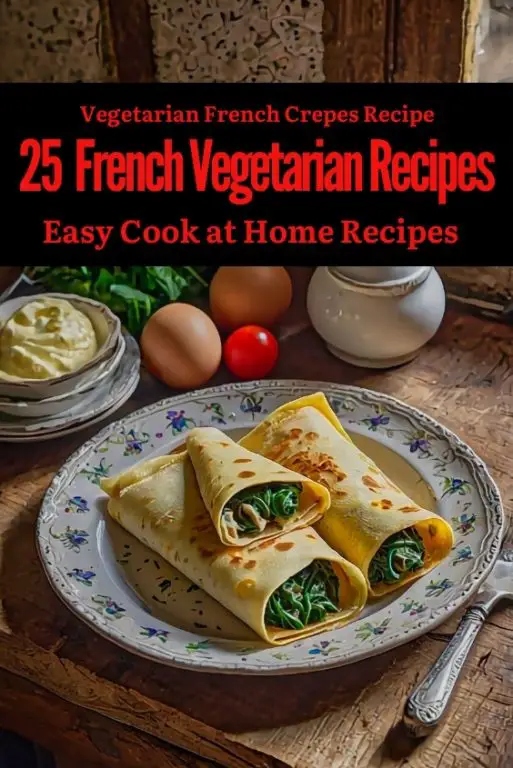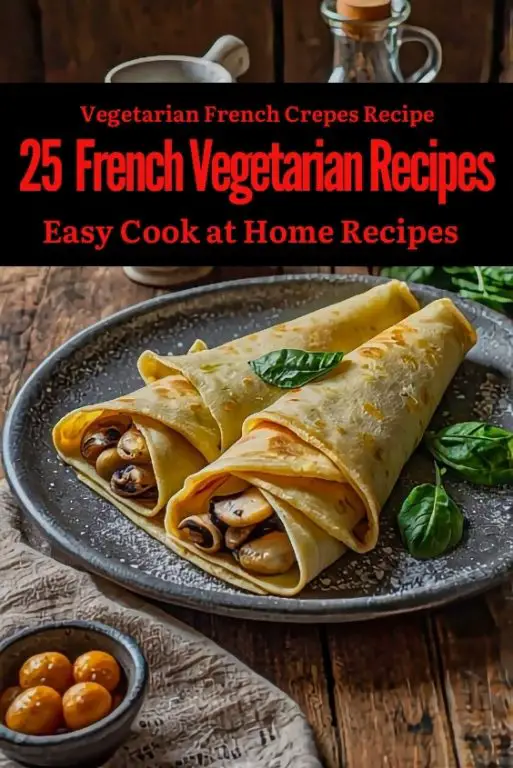Vegetarian French Crepes – a delight that stole my heart in the charming streets of France. As a food blogger, I began a journey to gather recipes and take cooking classes to create content for my blog, and this dish was one of the highlights of my trip.
During my stay in France, I had the opportunity to attend a cooking class focused on vegetarian cuisine, where I learned the art of making Vegetarian French Crepes from a local teacher. The class was held in a cozy kitchen that was filled with the aroma of freshly baked bread and the sound of sizzling vegetables. Our instructor led us through the process of preparing the crepes, sharing tips and tricks along the way.
As we cooked, our instructor emphasized the importance of using high-quality ingredients and techniques to create a dish that is both flavorful and healthy. To make the recipe healthier, she suggested using whole wheat flour instead of all-purpose flour, reducing the amount of sugar in the filling, and adding fresh herbs for extra flavor. These tips were invaluable, and I couldn’t wait to share them with my readers.
The Vegetarian French Crepes themselves were thin pancakes filled with a rich and creamy mixture of cheese, spinach, and mushrooms. The combination of flavors and textures was perfection, and I found myself going back for seconds (and maybe even thirds).
One of the things that struck me most about this dish was its versatility. Our instructor showed us how to make both sweet and savory versions of the crepes, using different fillings and toppings to suit various tastes. This flexibility makes Vegetarian French Crepes an excellent option for brunch or dinner parties, as guests can customize their own crepes to suit their preferences.
Vegetarian French Crepes are a must-try for anyone looking to indulge in delicious and healthy French cuisine. With its rich flavors, delicate texture, and versatility, this dish is sure to become a favorite among foodies and health enthusiasts alike.
Ingredients For the Vegetarian French Crepes Recipe
All-purpose flour
Non-Dairy Milk
Large Eggs
Vanilla Extract
Salt
Cooking Oil or Melted Butter
Cooking Instructions For the Vegetarian French Crepes Recipe
- In a large mixing bowl, whisk together the flour, milk, eggs, vanilla extract, and salt until smooth and well combined.
- Heat a non-stick frying pan or crepe pan over medium heat.
- Lightly grease the pan with cooking oil or melted butter.
- Pour about 1/4 cup of the batter into the pan, swirling it around to evenly coat the bottom.
- Cook the crepe for about 1-2 minutes until the edges start to turn golden brown.
- Flip the crepe using a spatula and cook for an additional 1-2 minutes on the other side.
- Transfer the cooked crepe to a plate and repeat the process with the remaining batter, greasing the pan as needed.
- Serve the crepes warm with your choice of sweet or savory fillings.
10 Reasons I love France Vegetarian Food
1. Fresh, Seasonal Ingredients
One of the best things about French vegetarian food is its emphasis on fresh, seasonal ingredients. Local markets in France offer a wide variety of vegetables, herbs, and fruits that reflect what is in season. This ensures that every dish is made with the ripest, freshest produce, giving the food a flavor and quality that’s hard to beat. French cooks pride themselves on using only the best ingredients, which makes even the simplest vegetable dishes taste exceptional.
2. Simple Yet Elegant
French vegetarian dishes are known for their simplicity, yet they are always prepared with an elegant touch. Many dishes require just a few ingredients, but the care and attention given to preparation result in meals that are refined and full of flavor. For example, a vegetable tart made with fresh zucchini, tomatoes, and onions can be a delightful dish when baked with a perfectly crisp pastry. This balance between simplicity and sophistication is what makes French vegetarian food so appealing.
3. Delicious Use of Herbs
Herbs play a significant role in French vegetarian cuisine, adding layers of flavor and aroma to dishes. Fresh herbs like thyme, rosemary, parsley, and tarragon are often used to enhance soups, stews, and roasted vegetables. French cooks also rely on herbes de Provence, a blend of dried herbs, to season vegetables and create delicious marinades. These herbs not only add fragrance to dishes but also elevate the natural flavors of the ingredients, giving the food a fresh and vibrant taste.
4. Rich in Tradition
French vegetarian food is steeped in culinary tradition, with many dishes having been passed down through generations. Classics like ratatouille, a vegetable stew from Provence, or tarte aux légumes, a savory vegetable tart, reflect the country’s rich food heritage. These dishes are not only beloved for their flavor but also for the cultural history they represent. Eating French vegetarian food often feels like experiencing a piece of France’s long-standing culinary traditions, making it a truly enriching experience.
5. Versatile Cooking Methods
French cuisine showcases a variety of cooking methods, each bringing out unique textures and flavors in vegetables. Roasting, for example, enhances the sweetness of root vegetables, while sautéing brings out the rich flavors of mushrooms and onions. Steaming preserves the freshness and nutrients of delicate greens, while baking creates crispy, golden crusts for vegetable tarts and gratins. This versatility allows French vegetarian dishes to offer diverse textures and flavors, ensuring that each meal is a delightful experience.
6. Cheese-Lover’s Dream
France is world-renowned for its wide selection of cheeses, and many vegetarian dishes incorporate these delicious ingredients. From soft and creamy goat cheese to the nutty flavors of gruyère and comté, French cheeses add richness and depth to vegetarian meals. Whether melted into a vegetable gratin, sprinkled over a salad, or baked into a tart, cheese plays a starring role in many French vegetarian dishes. For those who love cheese, French cuisine offers endless possibilities to indulge in flavorful, comforting meals.
7. Balanced Flavors
French vegetarian cuisine is all about balance. The flavors in each dish are carefully curated to complement one another, creating a harmonious taste experience. French cooks often use herbs and mild spices to enhance, rather than overpower, the natural flavors of vegetables. For example, in a dish like soupe au pistou, a vegetable soup with a basil-garlic sauce, the flavors of fresh vegetables are delicately balanced with the aromatic pistou, making the dish both satisfying and refreshing. This focus on balance is what makes French vegetarian dishes taste so refined.
8. Regional Specialties
One of the joys of French cuisine is the diversity of regional specialties, and this applies to vegetarian food as well. Each region of France has its own unique dishes that reflect the local ingredients and traditions. In Provence, for example, you’ll find vegetable-rich dishes like ratatouille and soupe au pistou, which highlight the region’s love for fresh produce and Mediterranean flavors. In Brittany, vegetarian buckwheat crêpes filled with vegetables and cheese are a local favorite. Exploring the regional varieties of French vegetarian food offers a chance to discover new flavors and cooking styles.
9. Healthy and Satisfying
French vegetarian cuisine is not only delicious but also healthy. The use of fresh vegetables, herbs, and olive oil creates meals that are both light and nutritious. French vegetarian dishes often focus on simple, wholesome ingredients that provide plenty of vitamins and nutrients without being heavy or overly rich. At the same time, these meals are filling and satisfying, thanks to the thoughtful combinations of vegetables, grains, and legumes. Whether it’s a hearty lentil stew or a light vegetable salad, French vegetarian food strikes the perfect balance between health and flavor.
10. Beautiful Presentation
In France, the presentation of food is almost as important as the taste. French cooks take great care in arranging their dishes, ensuring that the meal is as visually appealing as it is flavorful. Vegetarian dishes are often presented with vibrant colors, showcasing the freshness of the ingredients. A simple salad, for example, might be artfully arranged with bright green lettuce, ruby-red tomatoes, and a sprinkling of fresh herbs. This attention to detail elevates the dining experience, making every meal feel like a special occasion. The beauty of French vegetarian food lies not only in its taste but also in the artistry of its presentation.
Eating Healthy As A Vegetarian in France
Eating healthy as a vegetarian in France is both enjoyable and feasible, thanks to the country’s emphasis on fresh, high-quality ingredients. French markets are abundant with seasonal fruits, vegetables, legumes, and grains, allowing vegetarians to access nutrient-rich produce year-round. Local farmers’ markets, known as marchés, provide a wide array of options, from fresh greens to root vegetables, making it easy to prepare balanced, wholesome meals. This focus on seasonal ingredients ensures that vegetarians in France can enjoy meals packed with vitamins, minerals, and antioxidants.
French cuisine is traditionally known for its emphasis on vegetables and legumes, especially in regions like Provence. Dishes such as ratatouille—a stew made with tomatoes, zucchini, and eggplant—are naturally vegetarian and offer plenty of fiber, vitamins, and minerals. Soups, like soupe au pistou, made with fresh vegetables and herbs, are not only filling but also low in calories and full of essential nutrients. For protein, lentils and beans are commonly used, such as in lentil salad, which is a popular vegetarian option found in many French cafes and bistros.
One of the challenges of eating healthy as a vegetarian in France is navigating meals at restaurants, where meat-heavy dishes like coq au vin or cassoulet dominate the menu. However, many restaurants now offer vegetarian or plant-based options, and dishes like vegetable tarts, salads, and cheese-based gratins can be enjoyed without sacrificing nutrition. Pairing these meals with whole-grain bread, fresh fruit, and a glass of water or herbal tea keeps the diet balanced and healthy.
Overall, the emphasis on fresh produce, herbs, and high-quality ingredients in French cuisine makes it easy for vegetarians to maintain a nutritious diet while enjoying the rich flavors that define French cooking.
Vegetarian Diet in France
The history of the vegetarian diet in France spans centuries, evolving from ancient practices to modern dietary trends. In ancient times, vegetarianism was not a widespread practice in France, as the diet of the region was primarily based on agriculture, including the consumption of grains, vegetables, and some animal products. However, during the Roman occupation of Gaul (modern-day France), Roman influence introduced more diverse food habits, including an increased reliance on meat, fish, and dairy. While the ancient diet included many plant-based foods, there was no widespread cultural movement promoting vegetarianism.
During the Middle Ages, French diets remained largely agrarian, with peasants relying on vegetables, grains, legumes, and occasional dairy or meat when available. However, the religious orders in medieval France played a significant role in shaping early vegetarian practices. Monastic communities often abstained from meat during fasting periods, favoring plant-based meals, soups, and bread. These dietary restrictions were tied to religious observances, and while not purely vegetarian, they influenced early plant-based eating habits in France.
In the 19th century, vegetarianism began to emerge more formally in Europe, including France, as part of broader health movements and moral considerations. Influenced by the vegetarian philosophies gaining traction in Britain and Germany, French intellectuals and reformers started to explore plant-based diets. Figures like writer and philosopher Alphonse de Lamartine and the famous French lawyer Émile Zola were among those who discussed the ethical and health benefits of a vegetarian lifestyle. This period marked the beginning of vegetarianism as a conscious choice for health, ethics, and environmental concerns, though it remained a niche movement in France.
The modern vegetarian movement in France gained momentum in the 20th century, especially post-World War II, with increasing awareness of health and environmental issues. In the 1970s and 1980s, the rise of natural food stores and vegetarian restaurants began to reflect a growing demand for plant-based diets. Influenced by global trends in vegetarianism, including movements from the United States and India, French society slowly started to embrace vegetarian options, particularly in urban centers like Paris.
Today, vegetarianism is more mainstream in France, though it remains less prevalent than in some other European countries. Many French people, especially in urban areas, adopt vegetarian or flexitarian diets for health, ethical, or environmental reasons. With a greater variety of vegetarian products available in supermarkets and the rise of plant-based restaurants, the vegetarian diet has become a significant part of modern French food culture.
FAQ For the Vegetarian French Crepes Recipe
Q: What ingredients are essential for a Vegetarian French Crepes Recipe?
A: A Vegetarian French Crepes Recipe typically includes simple yet essential ingredients. The base consists of all-purpose flour, eggs, milk, and a pinch of salt, creating a smooth batter. For a richer flavour, some recipes may incorporate melted butter or oil. You can also add vanilla extract for sweetness, particularly when making dessert crepes. For savory versions, consider adding herbs like thyme or chives to the batter. These ingredients combine to create delicate crepes that are versatile enough to be filled with both sweet and savoury options.
Q: How do you prepare the batter for a Vegetarian French Crepes Recipe?
A: To prepare the batter for a Vegetarian French Crepes Recipe, start by whisking together the flour and salt in a mixing bowl. In a separate bowl, combine the eggs and milk, mixing until well blended. Gradually pour the liquid mixture into the flour, stirring continuously to avoid lumps. Once combined, let the batter rest for at least 30 minutes at room temperature; this allows the gluten to relax, resulting in tender crepes. Before cooking, give the batter a gentle stir, ensuring a smooth consistency ready for the pan.
Q: Can you make a Vegetarian French Crepes Recipe ahead of time?
A: Yes, you can make a Vegetarian French Crepes Recipe ahead of time, making it convenient for meal prep or entertaining. Prepare the crepes and allow them to cool completely before stacking them with parchment paper between each layer to prevent sticking. Store the stack in an airtight container in the refrigerator for up to three days. When ready to serve, simply reheat the crepes in a non-stick pan over low heat, adding your desired fillings before folding or rolling. This method allows for a quick and easy meal at any time.
Q: How do you serve a Vegetarian French Crepes Recipe?
A: A Vegetarian French Crepes Recipe is incredibly versatile and can be served in various ways. For sweet crepes, you can fill them with ingredients like fresh fruits, Nutella, or whipped cream, dusting with powdered sugar before serving. For savory crepes, popular fillings include sautéed vegetables, cheese, or even a spinach and ricotta mixture. To enhance the presentation, consider folding the crepes neatly on a plate and garnishing with fresh herbs or a drizzle of sauce. This approach creates an attractive and delicious dish suitable for breakfast, lunch, or dessert.
Q: What are some variations of the Vegetarian French Crepes Recipe?
A: There are many delicious variations of the Vegetarian French Crepes Recipe to suit different tastes and occasions. For a gluten-free option, you can substitute all-purpose flour with a gluten-free flour blend, ensuring a similar texture. You can also experiment with plant-based milk, like almond or oat milk, for a dairy-free version. Sweet variations can include adding cocoa powder or cinnamon to the batter for extra flavour. Savoury options might feature adding cheese or finely chopped vegetables directly into the batter for added texture. These variations keep the dish exciting and adaptable.

Vegetarian French Crepes Recipe
Equipment
- large mixing bowl
- whisk
- Non-stick frying pan or crepe pan
- Spatula
- Plate or platter for serving
Ingredients
- 2 cups all-purpose flour
- 2 cups milk
- 4 large eggs
- 2 teaspoons vanilla extract
- 1/4 teaspoon salt
- Cooking oil or melted butter for greasing the pan
Instructions
- In a large mixing bowl, whisk together the flour, milk, eggs, vanilla extract, and salt until smooth and well combined.
- Heat a non-stick frying pan or crepe pan over medium heat.
- Lightly grease the pan with cooking oil or melted butter.
- Pour about 1/4 cup of the batter into the pan, swirling it around to evenly coat the bottom.
- Cook the crepe for about 1-2 minutes until the edges start to turn golden brown.
- Flip the crepe using a spatula and cook for an additional 1-2 minutes on the other side.
- Transfer the cooked crepe to a plate and repeat the process with the remaining batter, greasing the pan as needed.
- Serve the crepes warm with your choice of sweet or savory fillings.





1 comment
These crepes were light and versatile, perfect for any meal. I filled them with fresh berries and a drizzle of maple syrup for breakfast, and they turned out amazing. I can’t wait to experiment with different fillings next time.
Comments are closed.